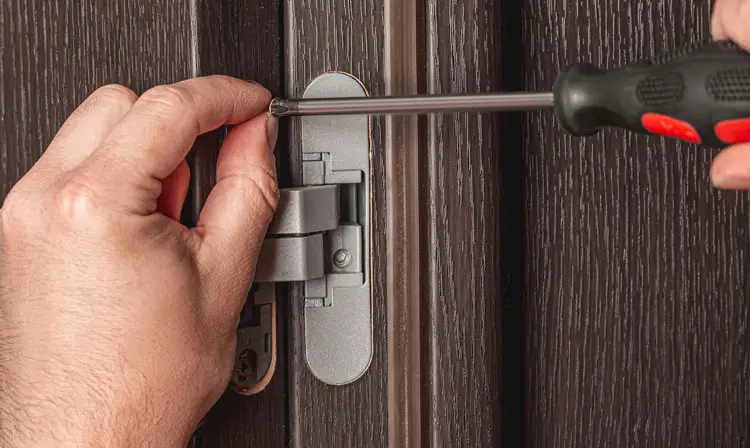Are you having trouble locking your door? Is the latch not extending fully?
This is a common problem that various things, such as misalignment, wear and tear, dirt, or damage can cause.
In this article, I’ll show you how to fix a door latch that refuses to extend fully so you can restore the functionality and security of your door.
A door latch may not extend fully due to misalignment, a loose strike plate or hinges, tight screws, worn-out latch components, or a warped door frame. Sometimes dirt or debris blocks the latch mechanism. You need to find the root cause of the problem first to be able to fix it.
Why a Door Latch Won’t Extend Fully: Causes & Fixes
Several factors can contribute to a door latch not extending fully. Understanding these causes can help you diagnose and address the issue quickly. Here are the most common reasons and the solutions:
A Build-up of Dirt and Debris
One of the common reasons why a door latch may not extend fully is the build-up of dirt. Dirt can accumulate inside the latch mechanism over time and prevent it from moving smoothly. This can cause the latch to stick or jam and not reach its full extension.
Solution
To fix this problem, you need to clean the latch mechanism and lubricate it. Here are the steps:
- Use a screwdriver to remove the screws that hold the latch plate on the door edge. The latch plate is the metal piece that covers the latch mechanism.
- Pull out the latch plate and set it aside. You should see the latch sticking out of the door edge.
- Use a cloth or a brush to wipe away any dirt or debris from the latch and the surrounding area. You can also use a vacuum cleaner to suck up any loose particles.
- Spray some lubricant (such as WD-40) on the latch and its moving parts, such as the spring and the pin. Make sure to cover all the surfaces that come in contact with each other.
- Move the latch back and forth several times to distribute the lubricant and loosen any stuck parts.
- Reattach the latch plate on the door edge with the screws. Make sure to align it properly with the latch and the strike plate on the door frame.
- Test the operation of the latch by opening and closing the door. If the issue was caused by dirt, the latch now should extend fully and retract smoothly.
Sometimes it may be sufficient to lubricate the door lock without dismantling it.
If you’re dealing with a jammed door, make sure you check out this handy guide.
Tilted Spindle
This is a pretty common cause if you have a recently installed new handleset. You may notice that the latch mechanism is binding.
Often the rectangular spindle that extends through the latch may be tilted and causes the latch mechanism to jam or bind.
Solution
To check if this is the case, loosen all screws, lift the exterior handle, and then tighten the screws while you keep lifting the door handle. This may help to make the spindle more level with the latch and fix the problem.
Over-Tightened Screws
If the screws that hold the door handle are excessively tightened, the pressure exerted on the latch mechanism causes the latch to stick and fail to extend fully. Surprisingly, this issue can even occur with new lock sets.
Solution
A simple solution is to loosen these screws. situated behind the inside door handle. By carefully adjusting the tightness of the screws, you can eliminate the strain on the latch, allowing it to extend smoothly.
Loose Hinges
Although hinges are located on the opposite side of the door, they have a big influence on the operation of the lock. Loose hinges are one of the possible reasons why a door latch does not extend fully.

Malfunctioning hinges can cause the door to sag and misalign with the strike plate on the door frame.
Solution
- Check the screws on the hinge leaves and if they are loose, use a screwdriver to tighten them. You may need to remove the hinge pins and lift the door slightly to access the screws.
- If the door still binds on the latch side, you may need to set the hinges or the strike plate deeper into the wood. You can use a chisel and a hammer to create a recess for them and then screw them back in place.
Misaligned Strike Plate
The strike plate is the metal plate on the door frame that the latch bolt slides into. If the strike plate is misaligned, the latch bolt may not be able to extend fully.
This can be caused by several factors, such as loose screws or a warped door frame.
Solution
To fix this issue, you may need to adjust the strike plate or replace it altogether.
- First, check if the screws are tightened properly.
- Sometimes you just have to loosen the screws on the strike plate and adjust its position slightly until the latch catches.
- If the above solution does not work, then you may need to enlarge the hole on the strike plate with a metal file or a drill bit to allow more room for the latch.
- You may need to remove the strike plate and reposition it on the door frame using a chisel and a hammer to create a new recess for it.
Here’s a handy tutorial:
Loose Screws
One of the possible reasons why a door latch may not extend fully is that the screws holding the latch plate are loose. This can cause the latch plate to shift and prevent the latch from reaching the strike plate on the door frame.
Solution
To fix this problem, simply tighten the screws using a screwdriver. If the screws are stripped or damaged, you may need to replace them with new ones. Make sure the latch plate is aligned with the strike plate before tightening the screws.
Broken Latch Mechanism
If none of the above solutions work, the latch mechanism itself may be broken. This can be caused by a variety of factors, such as excessive force being applied to the door or a manufacturing defect.
If this is the case, you may need to replace the entire latch mechanism.
Worn Out Latch Bolt
Over time, the latch bolt on your door can become worn out, making it difficult for it to extend fully. This can be caused by normal wear and tear, or it could be due to a lack of maintenance and lubrication.
Solution
If the latch bolt is not extending fully due to wear and tear, you may need to replace it with a new one. You can find the right latch mechanism for your door by checking the model number and the manufacturer of your door hardware.
While replacing a door latch is usually not an extremely difficult task, there are situations where you may need to call a locksmith, especially if you’re a newbie DIYer.
Conclusion
As you can see, there are several possible reasons why your door latch isn’t extending fully and preventing your door from locking properly.
Some of the common causes are a buildup of dirt or debris around the latch, a faulty latch mechanism, a damaged or misaligned strike plate, a warped door frame, and improper installation of the door latch. If you are unable to identify the cause of the problem yourself, don’t worry, just contact a qualified locksmith or handyman for help.
FAQs
Can I fix a door latch issue myself?
Simple door latch issues, such as adjusting the strike plate or lubricating the latch mechanism, can often be addressed by homeowners. However, complex problems or extensive damage may require professional assistance depending on your skills and experience.
How much does it cost to replace a door latch?
The cost of replacing a door latch can vary depending on factors such as the type of latch, the complexity of the installation, and local labor rates. While a door latch costs only a few bucks, the labor costs for installation are usually between u003ca href=u0022https://www.airtasker.com/us/costs/door-knob-installation/doorknob-installation-cost/u0022 target=u0022_blanku0022 rel=u0022noreferrer noopeneru0022u003e$37 and $190u003c/au003e
How do you fix a gap between a door and a lock?
One common method is to use cardboard shims behind the hinges of the door to adjust the alignment of the door and reduce the gap on the lock side. Another method is to replace the weather stripping on the sides of the door to seal the gap and provide insulation. If the gap is caused by a damaged or warped door frame, you may need to repair or replace the frame.












